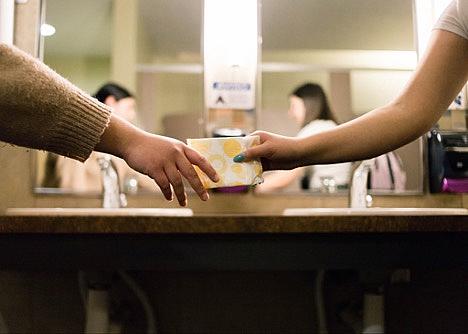Period Poverty: Exploring the stigmatization and solutions to one of America’s most silent issues

(Photo by Annika Gordon/Unsplash)
As progressive as it seems our society has become, we still avoid discussing periods and menstrual health, neglecting the fact that over 800 million people menstruate daily.
Pretending that periods don’t exist doesn’t make them disappear, but it does contribute to a widespread global phenomenon: menstrual poverty. Menstrual poverty, or period poverty, is defined as a lack of access to menstrual products, education, hygiene facilities, or waste management. It is an issue that heavily impacts the homeless, low income, and Black and Brown communities. Research by Reuters in 2019 showed that two-thirds of low income women in the United States could not afford menstrual products during the previous year, and half of those women said that at times they had to choose between buying food or period products. It is a forced decision between diet and hygiene, two key components for maintaining one’s health.
As part of my reporting for the 2022 National Fellowship, I plan to deeply explore these issues, with my long-term goals being to grant a platform to those most affected and initiate conversations with the ultimate goal of destigmatizing periods.
On the rare occasions that the media focuses on the issue, it is often white women leading the conversation. Examples of this include feminine hygiene brand Always partnering with actress Sophia Bush for their #EndPeriodPoverty campaign, an initiative to prevent school age girls from missing class due to lack of period products. Attempts to bring visibility to the conversation of periods are being had mostly by white women, like actress Busy Philipps modeling period underwear on social media and discussing her experiences having her period on her talk show Busy Tonight. This is not representative of who data shows is most affected by this issue — communities of color. It is extremely important for a community-focused newsroom like Latino News Network to explore an issue like this and give the microphone directly to those experiencing period poverty firsthand.
This project will consist of a series of both written and video content. The introductory piece will explain how the stigmatization of this issue has caused it to remain unaddressed for so long, especially for Latinx people who experience additional cultural barriers to discussing periods or seeking resources. It will also explain how local organizations in our network are working to bridge the gap between menstruating people and access to products required to maintain menstrual health. It will explore whether efforts like this in Illinois and any of Latino News Network’s other markets have a lasting impact in their communities.
Institutional sexism plays a heavy role in the way menstruation is experienced in the United States. In 2016, Illinois passed a law removing the “tampon tax” that previously taxed period products as luxury items; however, this isn’t the case in most states. Thirty states still implement additional taxes on period products, making them even more costly and harder for low-income people to afford. A second part to this series would explore the legalities of periods, the policymakers fighting to eliminate period taxes and those arguing to keep such taxes intact. This report will investigate the possibility of exempting such items from taxes altogether, because they are health essentials, or the possibility of utilizing government assistance programs such as SNAP, to purchase menstrual hygiene items.
While periods are often viewed as a women’s issue, some transgender men and nonbinary folks also experience periods, but are not included in the conversation. I would like to dedicate a part of the series to focusing on periods through a transgender or nonbinary lens to highlight their experiences and illuminate how they are affected my menstrual poverty. This exclusion is a shortcoming I’ve noticed through my own personal media consumption. As a journalist, I strive to be as inclusive as possible, so omitting this perspective would not provide fair and well-rounded coverage of the topic.
This reporting is important to me personally because I understand the discomfort caused by periods, the stigma that comes with bleeding and the irrationality behind our concept of gender. Not addressing menstrual poverty as an issue perpetuates gender inequality and continues the cycle for future generations. With the assistance of the Center for Health Journalism, my goal is to produce innovative storytelling on a longstanding issue that encourages people to comfortably discuss periods, and look to marginalized communities for insight on solutions that affect them the most.
